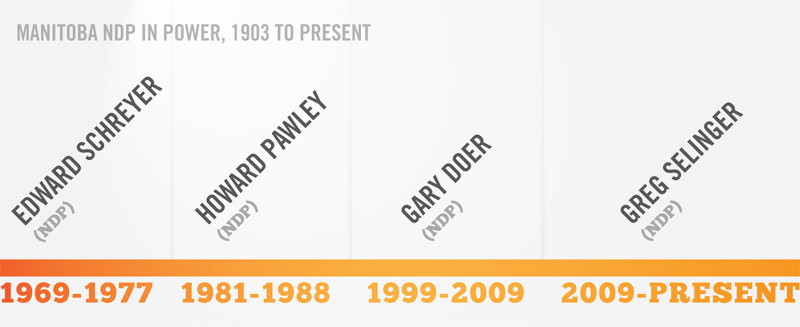The NDP through the past and into the future
Manitoba’s New Democratic Party turned 50 this year.
The party was born in 1961, with the support of labour unions wanting a new party to replace the weakened Cooperative Commonwealth Federation (CCF). But whether the party has lived up to their hopes of developing a more equitable society is a matter of ongoing debate.
The CCF never formed government in Manitoba. It was led and supported by British-born, working-class immigrants in north and central Winnipeg. The NDP initially relied mainly on their support, along with the formal endorsement of workers’ unions.
Within a decade of forming, the NDP came to power under Ed Schreyer. The party’s 1969 electors included, for the first time, ridings outside of Winnipeg, in northern and eastern areas of the province.
The NDP was starting to attract more diverse lower-income voters, regardless of ethnicity, as well as the growing middle class of teachers and health and social service professionals.
In following elections, the NDP lost to the Progressive Conservatives only once until the tables turned in 1988, and Gary Filmon’s PCs took over for three terms.
In 1999, Gary Doer’s NDP regained support from voters in the urban labour and social service sectors, and in Manitoba’s north. But it also won, for the first time, four south Winnipeg ridings.
The 2003 election added three more.
“They’ve been successful in getting a larger chunk of the middle political spectrum and middle income voter to support them – small business owners and other professionals,” said Marianne Cerilli, who was an NDP MLA until 2004.
Joan Grace, a University of Winnipeg politics professor, says social democratic parties worldwide have had to shift much more to the centre, or even the centre-right in some areas.
The reasons, she said, include the rise of neo-liberalism, criticism of governments’ high debt and deficits, and criticisms of the welfare state creating too much dependence on government programming.
“But the NDP in this province has, I think, attempted to maintain some semblance of their social democratic philosophy, their ideology,” Grace said.
Examples Grace gives include the tuition freeze, funding for childcare, the Neighborhoods Alive! program and a substantial increase in the minimum wage.
Gregory Furmaniuk, Canadian Federation of Students liaison for the University of Winnipeg Students’ Association, said one way the NDP appeals to youth is by promoting accessible and affordable post-secondary education.
He also appreciates their help with getting students living in residence included under the residential tenancies act, so they will have the same rights as other tenants.
For Premier Greg Selinger, initiatives like those are just business as usual.
“ For us it’s not just about growing the economy, it’s about making sure everybody has a chance to participate in it.
Premier Greg Selinger
“For us, it’s not just about growing the economy, it’s about making sure everybody has a chance to participate in it,” Selinger said. “We try to make sure that when we do anything, the benefits are available to everyone, not just the elites.”
As the party’s support expands, Selinger said the way to avoid alienating their traditional left-wing supporters is through a core commitment to things like social justice, neighborhood renewal, investment in young people, affordable housing, the environment, human rights and diversity.
Grace thinks one clear way to live up to their social democratic ideals would be by working more effectively on their environmental portfolio. Another would be a more substantive anti-poverty and social inclusion strategy.
But they’ve hesitated, she said, probably because of the cost.
“The realities of Manitoba’s economy and being a have-not province always colour and frame what a government can do and what it can’t do,” she said.
“Their biggest priority has been to stay in government ... in order to continue to do things,” Cerilli added. “I remember when Doer was there I used to say, ‘We expect more of you than keeping the other guys out.’ But I think they are doing more.”
The NDP has been gradually moving in a progressive direction, she added. Cerilli thinks avoiding hasty, disruptive change probably contributed to their success.
“I appreciate that was part of Doer’s strategy,” she said. “I think I appreciate that more than I did when I was there. When I was there, I was very upset about corporate tax cuts and those kinds of choices. It was all about sort of neutralizing the opposition.”
That approach worked well, Cerilli added, and government revenue continued to grow.
However, the NDP could be much more ambitious in fighting poverty with more affordable housing and childcare, as well as an increased earning exemption for people on welfare to help them transition into employment, she added.
Published in Volume 66, Number 5 of The Uniter (September 29, 2011)








